Corners are important. Goals following corners made up 13.9% of all the goals scored in the Premier League last season. 15.1% of all shots came after corners. Just about every team who can afford a specialist coach to focus on set-pieces employs one.
Once belittled as an ugly, brutish, and all-too British route to goal, elite teams are now proving the worth of corners with time dedicated to honing their skills and players signed with their set-piece ability – both taking them and being on the receiving end of them – in mind.
But ‘doing’ corners well takes imagination, skill and coordination. We’ve used our bank of data to analyse which teams are succeeding at corners, how they’re doing it and much more. Here are some of the most interesting takeaways from our analysis.
The Best and Worst Teams
North-London rivals Arsenal and Tottenham had contrasting seasons, but both were equally reliant on corners, scoring 13 goals apiece from corner kicks. Spurs’ goals from corners earned them 11 points in 2022-23; for Arsenal they were worth nine points. Take those goals away and Spurs would have only just scraped into the top half, while Arsenal would have finished level on points with Manchester United in third, and their title challenge would have been non-existent. The comeback wins over United and Bournemouth wouldn’t have happened and, well, the season would have been far less fun.
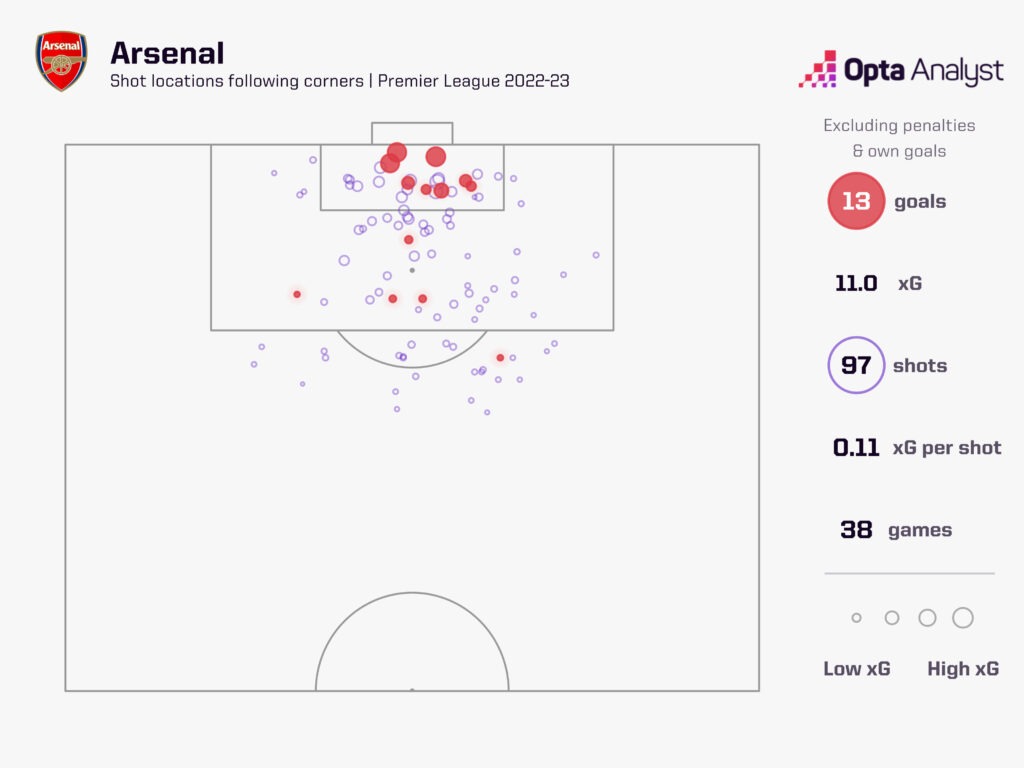
Arsenal’s 13 goals came from 11.0 xG, and as the above shot map shows, they were very good at creating extremely high quality chances close to goal, though they also scored a fair few from much more difficult chances, including Reiss Nelson’s late winner against Bournemouth and Oleksandr Zinchenko’s strike at Aston Villa. Those two goals also highlighted the impressive variety to Arsenal’s corners: Nelson’s was a crossed corner that was cleared to him on the edge of the box, while Zinchenko’s came from a short corner taken by Bukayo Saka to Martin Ødegaard, who spotted Zinchenko free on the edge of the box.
Tottenham’s 13 goals came from just 9.3 xG, with targeted near-post runs and flick-ons a significant part of their gameplan. These worked to good effect, with Spurs scoring three goals from the first contact at a corner, and also scoring a few tap-ins at the back post, too.
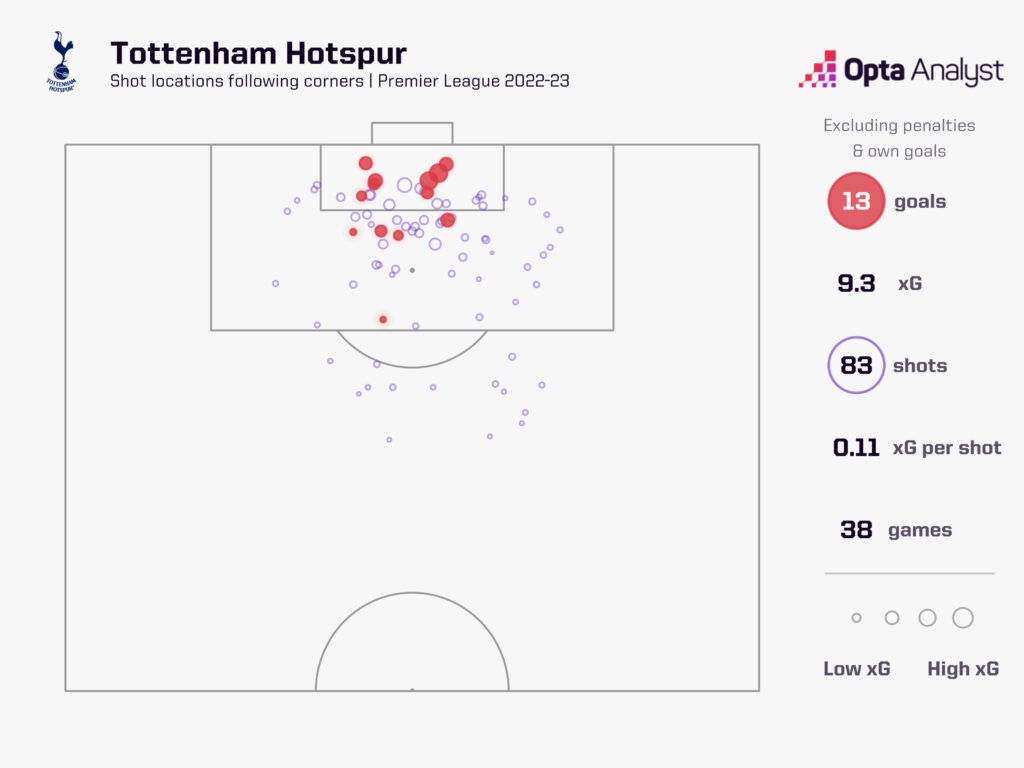
At the other end of the scale, Everton, Manchester United, Leicester City, Nottingham Forest and Brighton scored the joint-fewest goals at corners, with just four each. But it’s not as if there was a correlation between any specific approach to Premier League corners and success or lack thereof.
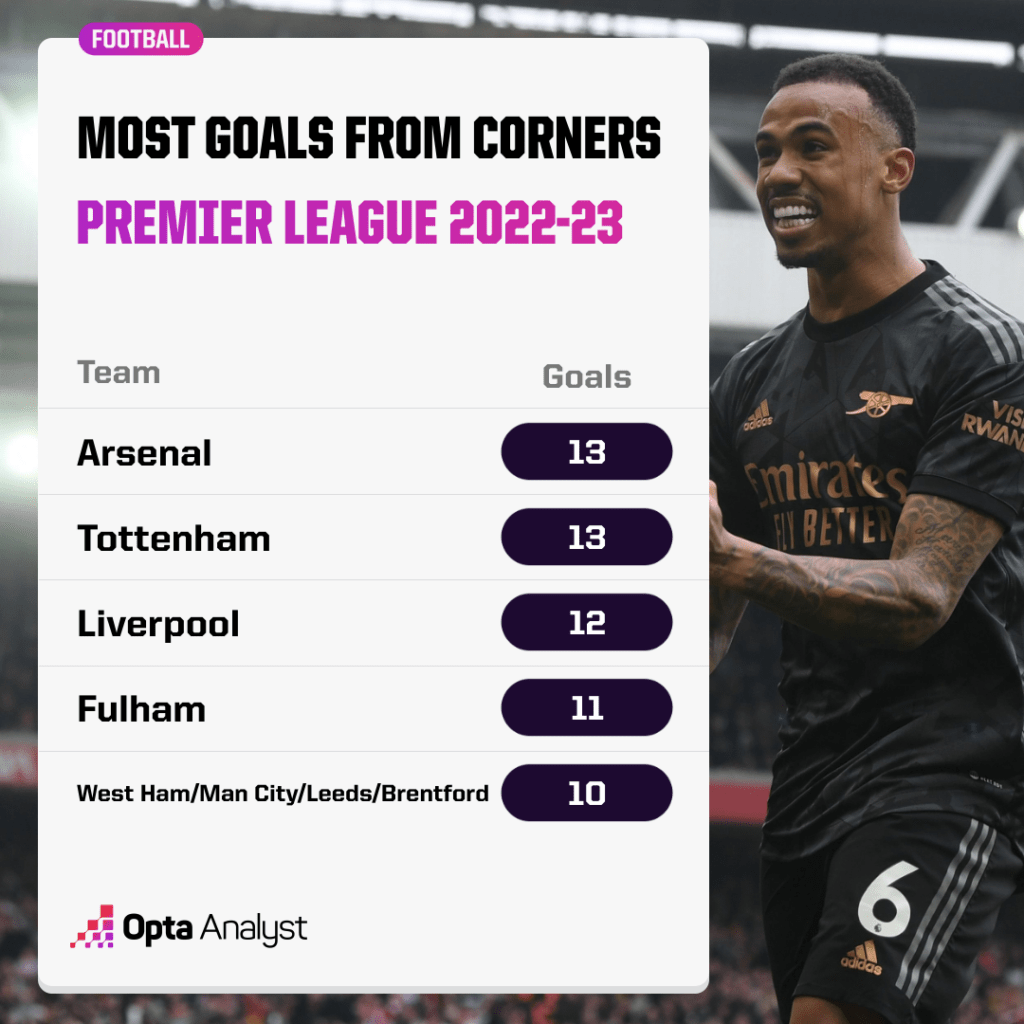
Inswingers (Arsenal) vs Outswingers (Liverpool)
Two teams who both enjoyed a lot of success at corners but had contrasting styles were Arsenal and Liverpool. Of Arsenal’s 165 crossed corners, 154 were inswingers, with their approach by far the most weighted towards one particular type of corner and, as mentioned above, they scored a joint league-high 13 goals from corners. Liverpool, meanwhile, took 155 of their 212 crossed corners as outswingers. Jürgen Klopp’s side scored 12 goals from corners – just one fewer than Arsenal and Tottenham – with the most heavily-weighted approach towards outswingers.
So, which is best?
One way in which our corner data is split is into actions directly from the corner (the very first on-ball action after the corner is taken) and actions in the passage of play following the corner. Shots directly from corners are incredibly rare, and even more so when your corners are inswingers. Inswinging corners led to a shot from the first contact 16.9% of the time in the Premier League last season, whereas the first contact was a shot from outswingers 25.1% of the time.
However, shots directly from inswinging corners were higher quality chances than outswingers, with an average xG per shot of 0.14 compared to 0.08.
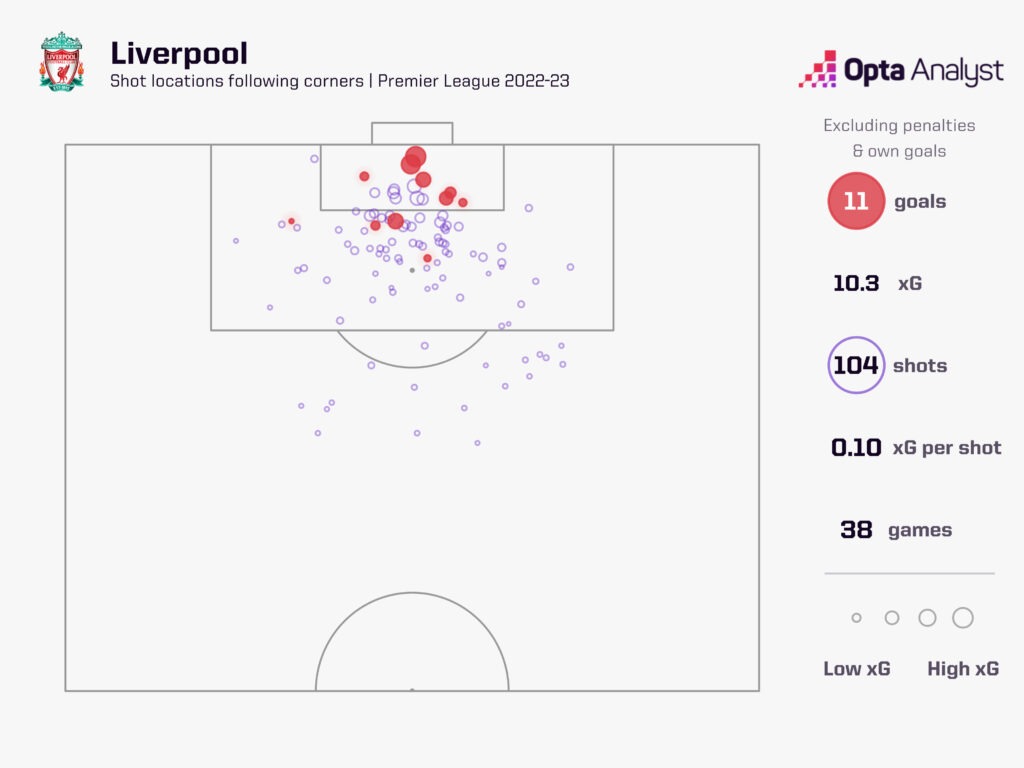
So, you get fewer chances from inswingers, but they tend to be better ones. These numbers actually (sort of) cancel each other out, and you end up with about the same number of goals directly from crossed corners whether they are inswingers or outswingers, with 1.32% of inswingers being converted and 1.25% of outswingers.
As we’ve established, shots direct from a corner are pretty rare, but even when looking at the whole passage of play following corners you see a remarkably similar story.
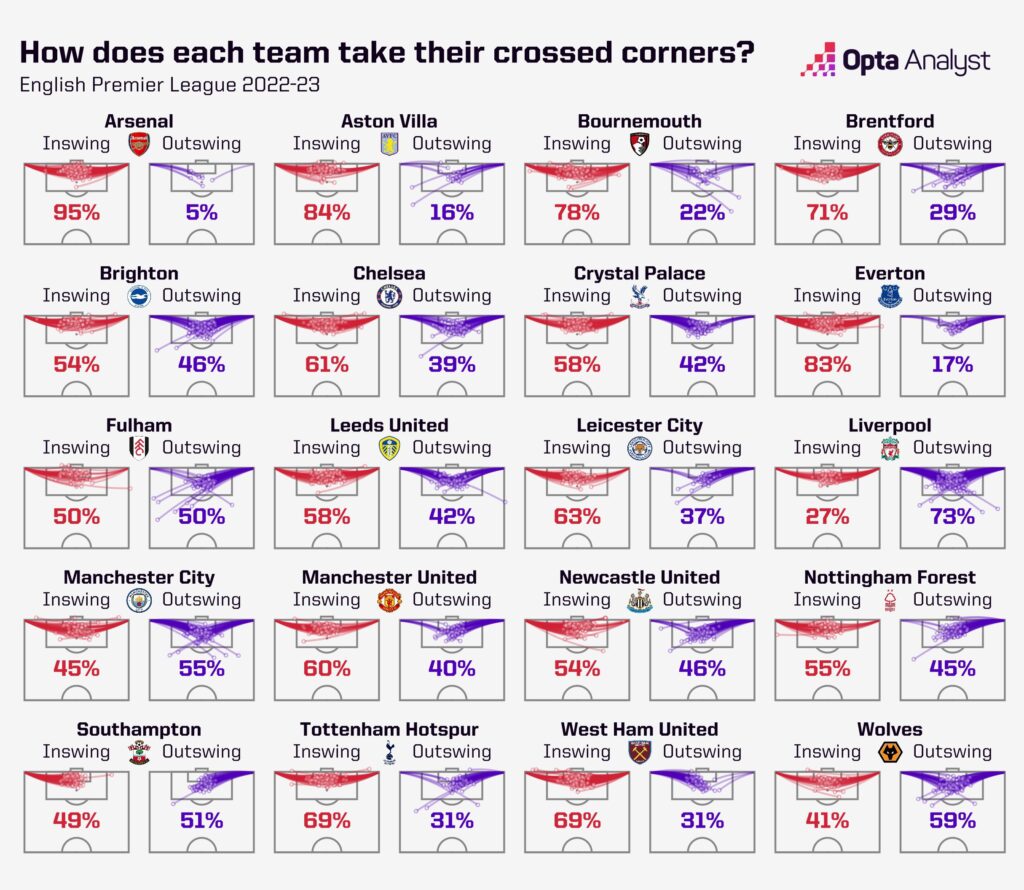
34.9% of inswinging crosses from corners led to a shot in that passage of play, compared to a very healthy 44.4% of outswingers. But 4.2% of inswingers led to a goal in the ensuing phase of play, compared to 4.1% of outswingers.
The explanation might have something to do with inswinging corners being more difficult to execute effectively, and more often failing to beat the first man. However, when they do reach a teammate, it is easier to flick or glance the ball towards goal than it is to redirect an outswinging cross.
So, as it turns out, inswingers and outswingers are as good as each other – as long as they are done well. It seems that focusing heavily on one type, as Arsenal and Liverpool did last season to great effect, is the key.
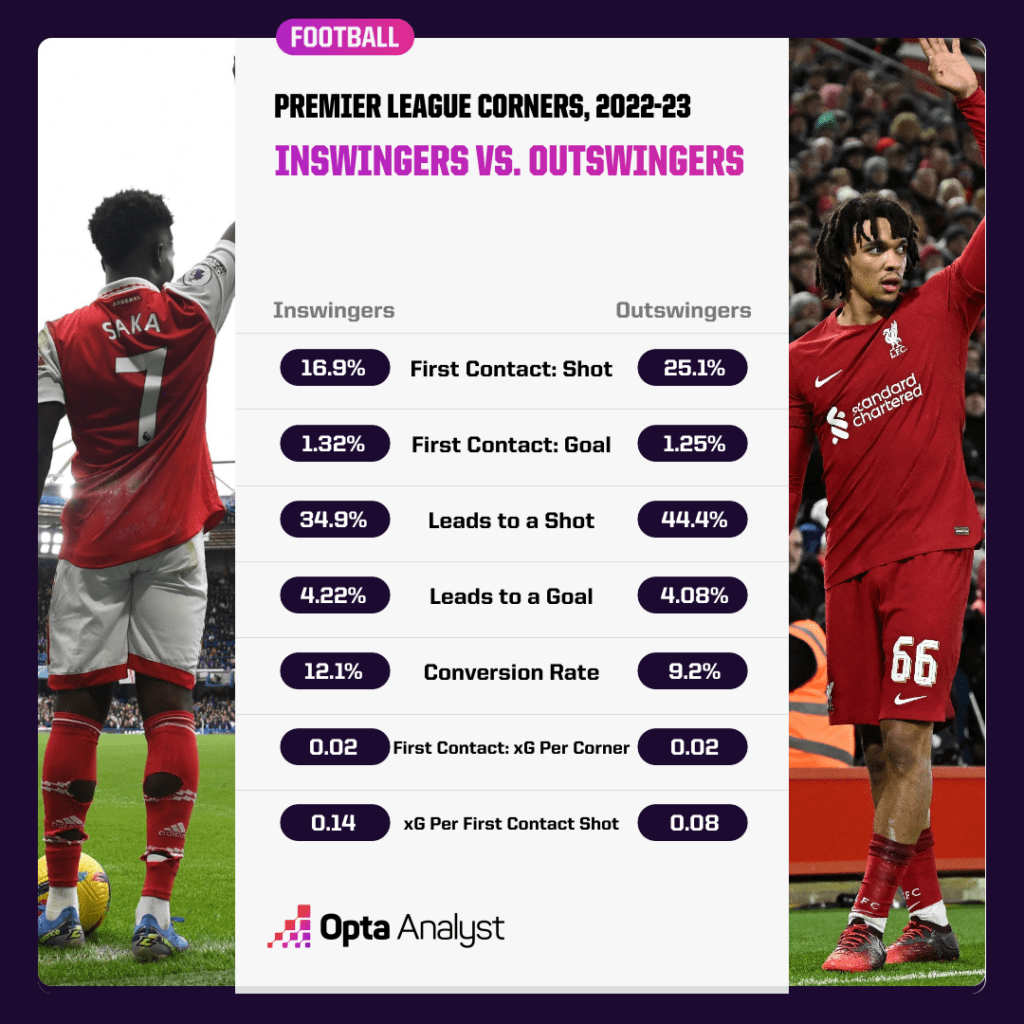
Short Corners vs Crossed Corners
Two teams focused heavily on each of these types of corners with equally underwhelming results. Everton crossed 95.4% of their corners directly into the middle, while Manchester United took 34.2% of their corners short – both the highest proportions of all teams. Both teams scored only four goals from corner situations – the joint lowest among all Premier League teams.
But Liverpool crossed 90.2% of their corners – which might come as a bit of a surprise, simply because most people would expect the teams who are better in possession would fancy their chances with short corners – and, as we’ve already seen, they were among the most effective teams at corners in the Premier League.
Crossed corners drew a shot directly from the corner 20.8% of the time last season, while a surprisingly high 2.8% of short corners brought a shot straight away. However, only 1.3% of crossed corners were directed straight into the net, and unsurprisingly there was only only one assist from a short corner all season, when Jack Harrison curled into the far corner against Brighton after receiving a pass to feet.
Short corners are widely disliked by fans who think the ball should be lumped into the box at any opportunity, and there is actually a little difference between the two. Only 32.6% of short corners led to a shot from that passage of play, and only 3.3% led to a goal. Both figures rise – to 38.5% and 4.1%, respectively – when looking at crossed corners. It isn’t much difference, but it is a difference, and the reason so many managers are focusing more on set-pieces these days is because they want to make any opportunity count when their team is close to goal.
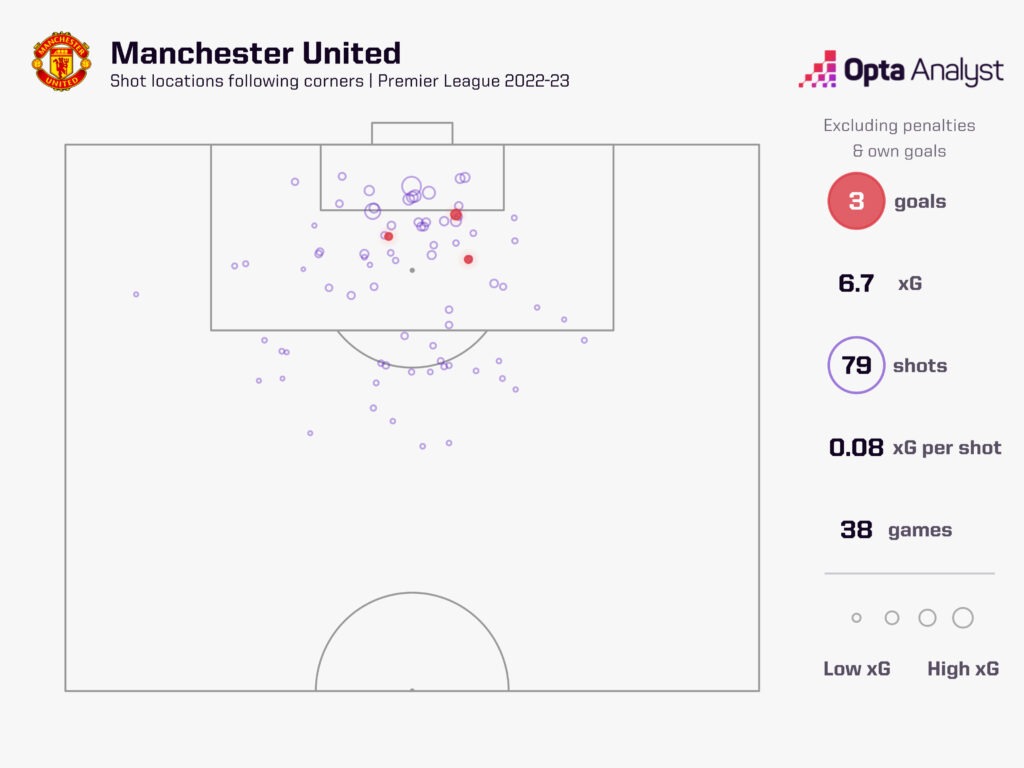
However, this analysis only looks at the passage of play resulting from the corner, and there are also times when a short corner is played all the way back into a team’s own half, and both teams reset to their shapes for ‘normal’ possession. Although this is exactly the kind of thing that gets a huge groan from impatient fans, it isn’t necessarily bad or unproductive and sometimes this kind of approach will lead to a chance or a goal. That’s a piece of analysis for another day…
Near Post vs Far Post
It makes sense that it is much more common for the first touch following a crossed corner to be in the zone close to the front post. It’s easier to find a player making a run across the near post than it is to find a player who has run through what would inevitably be a more crowded area at the back stick. Looking at corners crossed into the six-yard box, there were 68 shots from the first touch in the zone at the front post in the Premier League in 2022-23, compared to 42 at the back post. There were even more shots (72) when the first touch from a corner was in the centre part of the six-yard box.
However, the average xG of those shots varies considerably: 0.12 xG per shot at the front post; 0.17 xG per shot at the back post; 0.27 xG per shot in the centre of the goal. But those higher xG chances weren’t converted much more efficiently: there were nine goals scored from the first contact in the central part of the six-yard box (12.5% conversion rate), compared to eight from shots at the front post (11.8% conversion) and five from shots at the back post (11.9%).
One key difference, though, is how many more of the corners aimed to the back-post zone resulted in shots. Of the corners where the first contact was at the back post, 25.8% were turned towards goal compared to 13.2% at the front post and 12.2% in the centre. Almost two times as many of the corners where the first contact was at the back post were converted into goals (3.1%) as corners to the front post (1.6%) and to the middle of the goal (1.5%).
One possible explanation for this tiny quirk of the numbers could be that right in front of goal in a crowded six-yard box defenders will push their opponent, happy to use any tactic they can to put an attacker off. This kind of physical contact isn’t something that xG models take into account, after all. Or perhaps one Premier League season isn’t a big enough sample size…
The Different Zones Teams Target
Last season, there were teams that stood out for targeting each of the front post, the back post, and the centre of the goal. Spurs heavily focused on balls towards the front post, with a league-high 19% of their corners put into that zone inside the six-yard box. That figure jumps to 29% when you include the area outside the six-yard box at the front post.
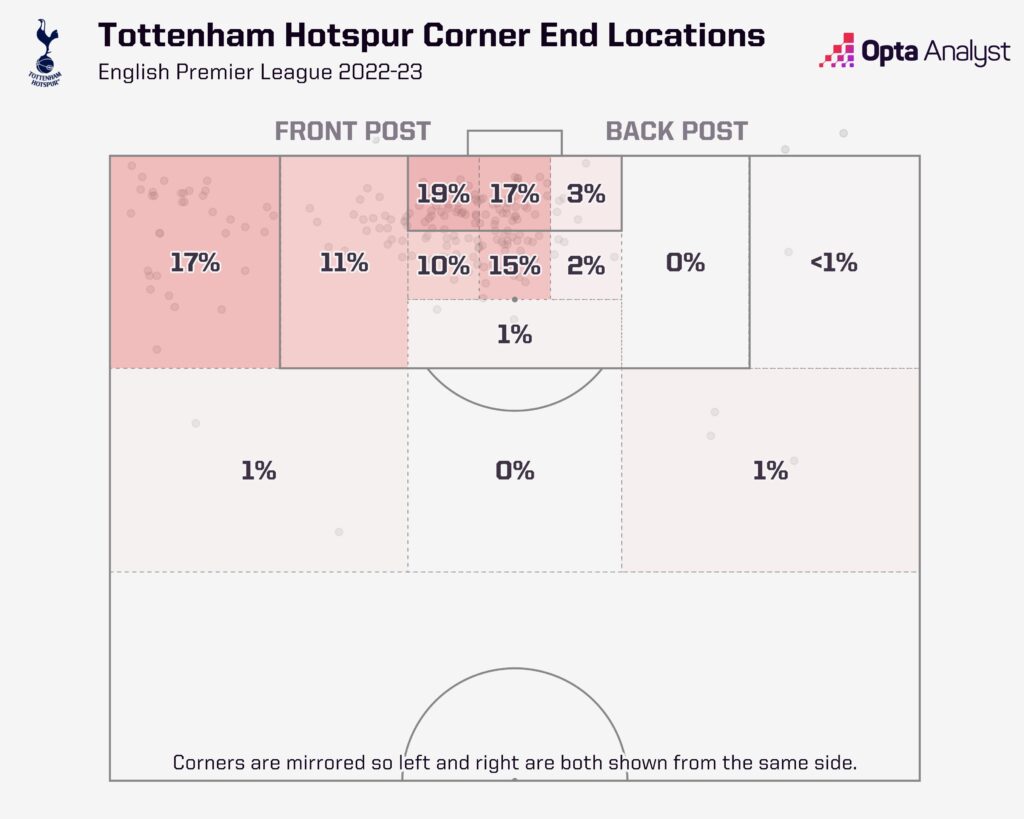
Very few of their corners were aimed directly at the far post, but as their shot map showed higher up this piece, they did get the ball into that zone one way or another – often with flick-ons – and to good effect.
Everton were most focused on back-post crosses, with 13% aimed towards that zone inside the six-yard box, or 20% if you include the space just outside the six-yard box. They were the only team in the whole top flight whose corners were more heavily weighted towards the back post of the six-yard box than the front (13% to 11%).
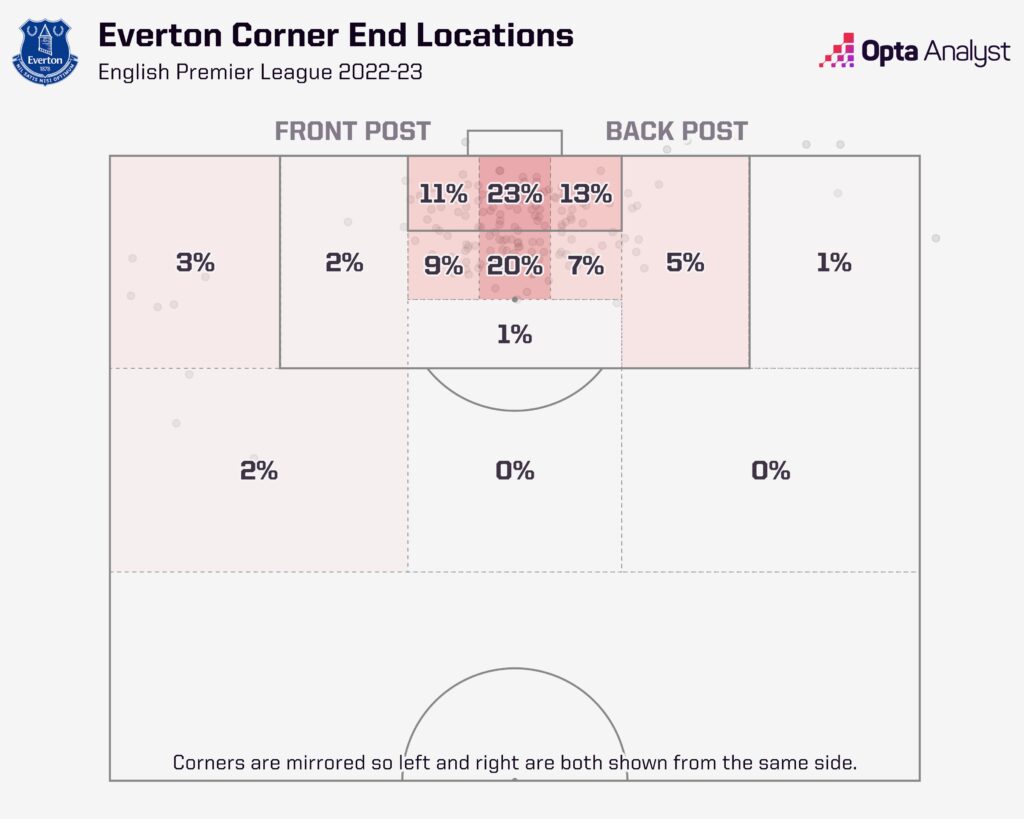
It isn’t clear, however, whether this was a conscious approach or a result of too many poorly taken and overhit crosses, because Everton scored only four goals from corner situations all season. Surely, that is going to be something that Sean Dyche aims to improve next season.
As for the middle of the goal, West Ham aimed the highest proportion of their corners into this zone, with 27% put into the six-yard box and a further 18% just outside it. They ranked joint fifth in the Premier League last season for goals at corners, with 10.
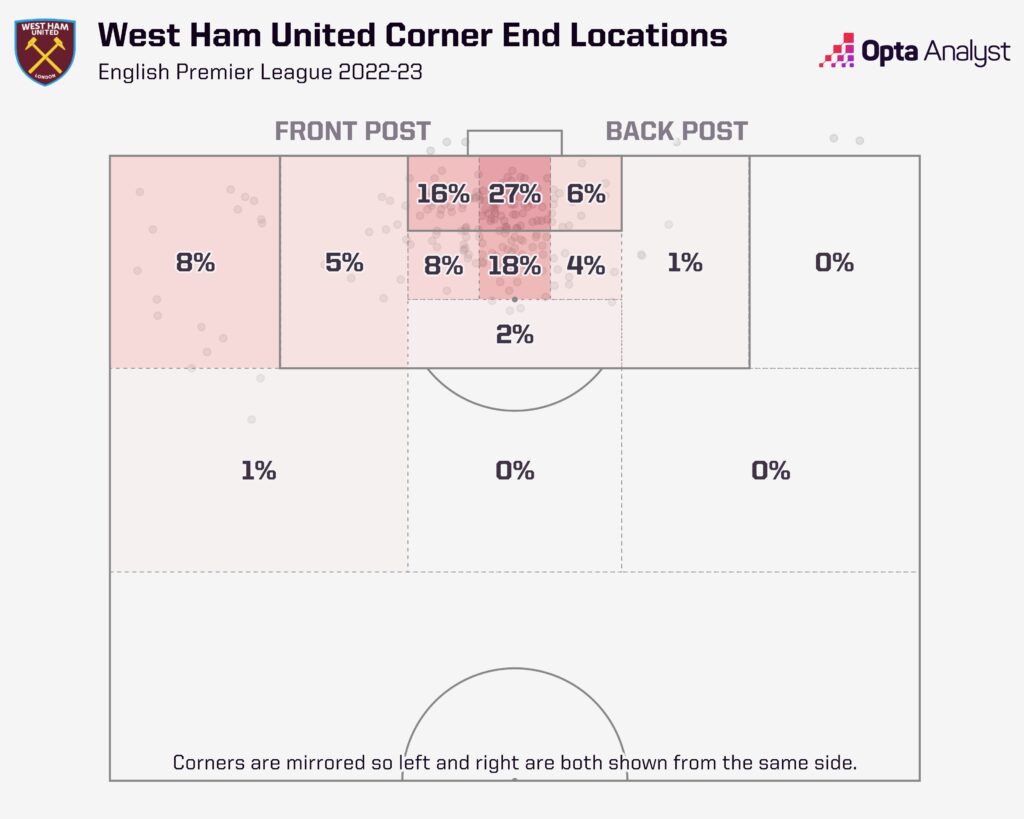
They were also the team that targeted the six-yard box more than any other team (that feels very David Moyes, doesn’t it?), with almost half of their corners (49.5%) aimed into the six-yard box. Given Everton (four goals) and Arsenal (13) ranked second and third for the proportion of their corners aimed into the six-yard box, clearly it’s a case of doing it well, rather than just getting the ball as close to goal as quickly as possible.
Liverpool, meanwhile, targeted the second six-yard box – the six-yard-box shaped zone directly outside the actual six-yard box – with 54.0% seeing the first touch following the corner in this zone. Virgil van Dijk was the target most often, with the Liverpool captain having 17 shots directly from corners last season, a tally only Newcastle’s Fabian Schär (21) could top.
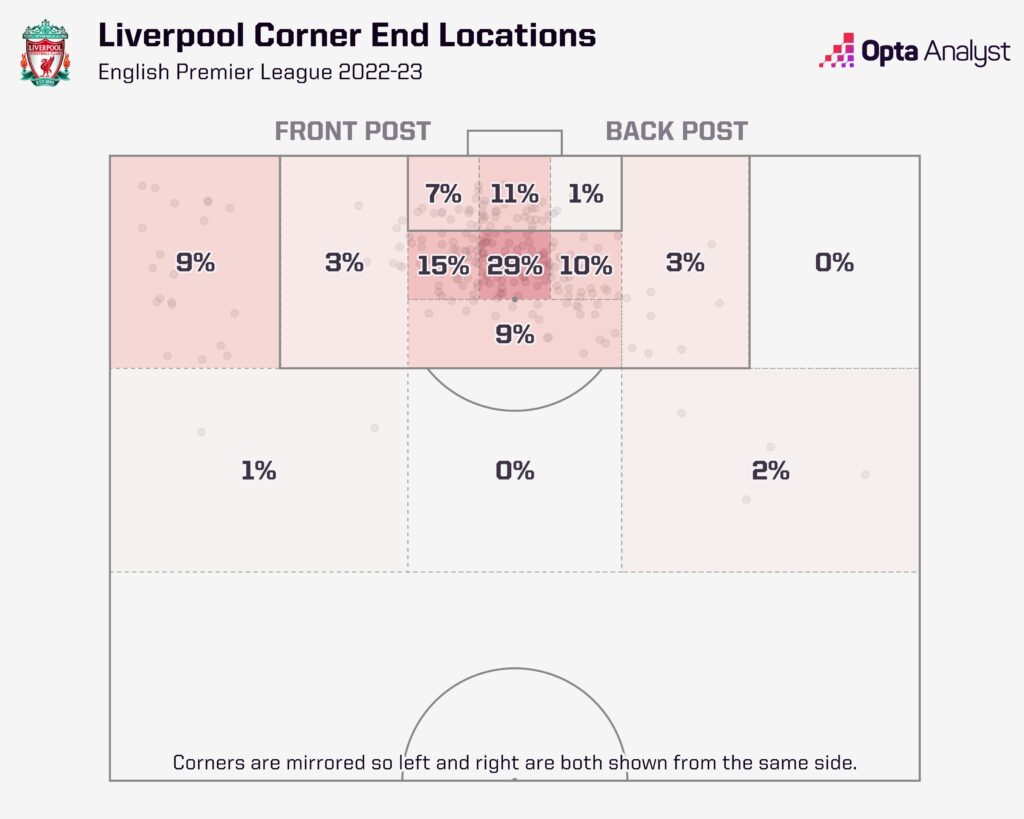
The Best Corner-Takers and Targets
Kieran Trippier had the highest xG assisted directly from corners in the Premier League last season, with 4.8, which was 1.8 higher than anyone else (Pascal Gross was second on 3.0). Schär was the main target, but he didn’t manage a single goal from his league-high 21 shots. Overall, only one of Trippier’s crosses from corners was converted directly into the net (while not a single one of Gross’ was).
The two most effective corner-takers when it came to goals direct from crosses were Tottenham’s Ivan Perisic and Fulham’s Andreas Pereira, who each registered three assists directly from corners. Pereira’s three goals came from 2.0 xG assisted, while Perisic’s were scored from just 1.6 xG assisted.
Perhaps Newcastle and Brighton have poor finishers attacking their corners, and they need to do some work to help those players score their attempts on goal by creating circumstances that will help them.
As for the most effective attackers in the box, although Schär (27), Van Dijk (24), James Tarkowski (24) and Aleksandar Mitrovic (21) were on the end of crossed corners more than anyone else, it was Arsenal’s Gabriel Magalhães who stood out most. Despite only getting on the end of 13 crossed corners, Gabriel scored more goals direct from corners than any other player in the entire top flight, with two.
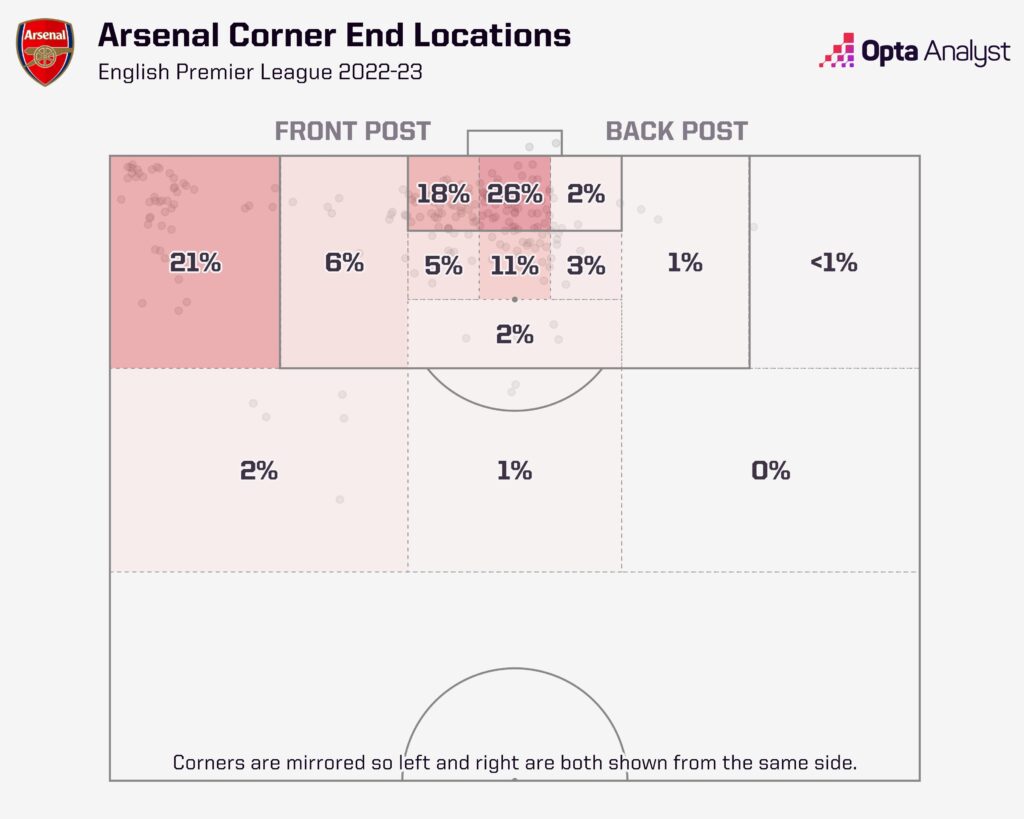
Another Reason Arsenal Signed Kai Havertz?
There are many reasons Mikel Arteta decided to sign, Kai Havertz, but not many people would have assumed that his ability at defensive corners was one of them. In truth, it was probably just an added bonus for Arteta, but it could prove an important one.
When it came to the first defensive contact following a crossed corner, Havertz was the best attacking player in the Premier League in 2022-23. His 23 first contacts at defensive corners was the fourth most in the whole top flight in 2022-23, behind only Brentford centre-back Ethan Pinnock (34) and Aston Villa centre-back Tyrone Mings (26) and goalkeeper Emiliano Martínez (24), and made up 12.6% of Chelsea’s total.
Furthermore, none of Arsenal’s four most effective ‘clearers’ of the ball at defensive corners were midfielders or attackers; they were one of only three teams in the Premier League last season for whom this was the case. While 17 teams could call on a big attacker to help out regularly at defensive corners, Arsenal weren’t able to. That will change this season.
They only conceded six goals following corners all season, which gave them the joint-fifth best record in the Premier League. However, perhaps crucially, their total was two more than Manchester City (four), and in a season of fine margins where you need to get everything perfect to topple City, Arteta will want his team to do anything they can to close the gap to Pep Guardiola’s side.
Enjoy this? Subscribe to our mailing list to receive exclusive weekly content. And follow us on Twitter too.
